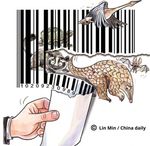ECOSYSTEM FOREST ANIMAL ENVIRONMENTALISSUE ACTIONS - JULY 2021 ISSUE 7
←
→
Page content transcription
If your browser does not render page correctly, please read the page content below
ENDANGERED ANIMALS An endangered animal is defined as any species at risk of extinction. Extinction of a species occurs when there are no more living individuals of that species. This could be caused by a sudden rapid decrease in its population due to threats to its existence such as pollution, habitat loss and other factors. One such example would be the extinction of dinosaurs that happened over 65 million years ago when a meteorite crashed into Earth. Extinction is a natural process and it is a part of evolution. The process of natural selection prunes out the weaker animals and allows for the stronger individuals to thrive and reproduce. Based on a study, scientists have estimated that for every species that are alive today, 10,000 of its primitive ancestors have gone extinct. However, the extinction of species that we see in our world today is different to the times of the dinosaurs. The rate of extinction today is mainly caused by humans and have increased thousands of times bigger than if it were to happen naturally. ANIMAL 01 July 2021
Tropical rainforests cover less than 10% of the Earth’s surface, while the ocean covers around 71% of the planet’s surface. On land, the biggest threat to animals is habitat loss, which is usually caused by deforestation. Deforestation refers to the clearing of forests for agricultural and economic purposes. When the forests are cleared and trees are cut down, animal populations will decrease drastically because they are unable to survive as they have lost their sources of food and homes. They are forced to venture outside of their shrinking forest into adjacent human areas to fulfill their needs, leading to human-wildlife conflicts. Loss of habitat, food source and human-wildlife conflict are major threats that have led to the extinction of many species. The human activity that threatens sea animals the most is the fishing industry. It is responsible for causing a depleting number of fish because of their unsustainable practices such as overfishing. Trawler boats that use non environmentally friendly gear like trawl nets tend to have a high bycatch rate. Though the intention is to catch fish, other species such as turtles, dolphins, sharks and rays get caught together and are killed. ANIMAL 02 July 2021
The coral reefs are badly impacted as well. Coral reefs, also known as the
“rainforest of the sea”, are home to an abundance of wildlife. Corals provide
shelter and food. If the coral reefs were to be destroyed, it will disrupt the food
chain in the coral ecosystem. As a result, it will cause some fish populations to
decline and possibly face extinction. A study estimates that there might be no
fish by 2050 if unsustainable fishing continues.
Besides the threats mentioned above, pollution also has a high impact on the
environment. Sewage, oil and gas pollutants and human wastes affect the
ecosystem, especially freshwater and marine ecosystems. These pollutants
and waste are unsafe to the animals and environment because they contain
toxic chemicals that fill the waters with high amounts of acid, oils and other
pollutants. For example, oil spills as shown in the picture below can decrease
the oxygen levels in the water
causing fish to suffocate and die.
Fish and filter feeder species (e.g.
shellfish) living in these polluted
waters will accumulate toxic
chemicals in their bodies. Human
beings are adversely affected
when they consume seafood
from these waters, because of the
high amounts of heavy metals it
contains, it can lead to various
health problems.
ANIMAL 03 July 2021The term "wildlife trade" refers to the sale
and trade of animals and plants or any
product made from them. It is a huge
business amounting to billions of dollars.
Unfortunately, uncontrolled and illegal
wildlife trade is a threat to many animals,
especially the endangered species. We
have lost over 90% of the world's wild
rhinoceros due to the demand for their
horn. Rhinoceros around the world are
slaughtered by poachers to obtain their
prized horn.
Another species targeted by the illegal wildlife trade are pangolins. Hunted for
their scales and despite increased protection, it continues to be exploited and
used in traditional medicine and as ornaments. Other animal species that look
cute such as sun bear cubs and slow lorises are sought after to fulfill the
demand for exotic pets. If the demand continues to increase, it will threaten
the wild population of species of birds, reptiles and primates which will
eventually result in the extinction of species.
ANIMAL 04 July 2021The threats to the wildlife population are also accelerated by the climate
change that we are experiencing now. Rising sea temperatures causes coral
bleaching and destroys the ocean habitats. The increase in sea temperatures
leads to a rise into the sea levels.
Rising sea levels push saltwater farther
upstream and increases the risk of
freshwater contamination caused by
sea waters. The consequences of these
are devastating to the people and
animals living in the coastal area.
All these factors will slowly lead to species extinction and the destruction of
the ecosystems, which are very difficult to restore. This biodiversity crisis is
caused by a single species, us, the humans. We are consuming resources
faster than the natural world can regenerate. Our unsustainable activities
have brought on rapid changes to the environment. However, it is still not too
late to protect our endangered animals. We have read many success stories by
passionate individuals who bring back species which were on the brink of
extinction. By working together, we can save our endangered animals.
ANIMAL 05 July 2021You can also read



























































